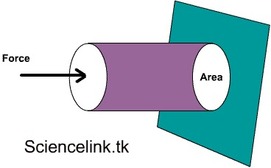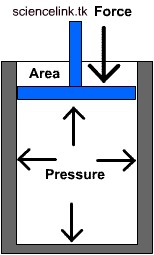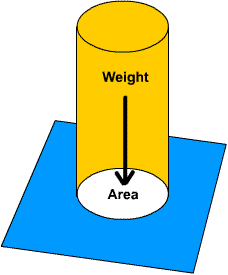What is pressure?
We can simply explain that pressure is force acting on an unit area.
How to measure pressure?
We can simply measure pressure by dividing force by surface area as above.
Pressure of solid on a solid
When you apply a force to a solid object, the pressure is defined as the force applied divided by the area of application. The equation for pressure is:
For example, if you push on an object with your hand with a force of 20 pounds, and the area of your hand is 10 square inches, then the pressure you are exerting is 20 / 10 = 2 pounds per square inch.
You can see that for a given force, if the surface area is smaller, the pressure will be greater. If you use a larger area, you are spreading out the force, and the pressure (or force per unit area) becomes smaller.
Solid pressing on confined fluid
When a liquid or gas is confined in a container or cylinder, you can create a pressure by applying a force with a solid piston. The pressure created in the cylinder equals the force applied divided by the area of the piston: P = F/A.
In a confined fluid—neglecting the effect of gravity on the fluid—the pressure is the same throughout the container, pressing equally on all the walls. In the case of a bicycle pump, the pressure created inside the pump will be transmitted through the hose into the bicycle tire. But the air is still all confined.
Increasing the force will increase the pressure inside the cylinder
Caused by gravity
Since the weight of an object is a force caused by gravity, we can substitute weight in the pressure equation. Thus the pressure (P) caused by the weight (W) of an object is that weight divided by the area (A) where the weight is applied.
P = W/A
If you place a solid object on the floor, the pressure on the floor over the area of contact is the weight of the object divided by the area on the floor.
Example with shoes
A good example of how a force on small area can result in a very high pressure is seen in women's shoes with high spiked heels. These types of shoes can cause damage to some floors due to the very high pressure on the floor at the heel.
An average shoe distributes the weight of the person over 20 square inches. Thus, a 100-pound person applies 100/20 = 5 pounds per square inch on the floor.
Since a spike-heel is only 0.25 square inches, the 100-pound person would be applying 100/0.25 = 400 pounds per square inch on the floor at the heel! In some cases, that is sufficient to damage the floor.
Fluid weight
If you put a liquid in a container, the weight of that liquid would be pressing on the bottom of the container similar to that of the weight of a solid object. The pressure on the bottom of the container would be the same as if the weight was from a solid: P = W/A.
The only difference is that pressure in a fluid goes in all directions. So the pressure on the sides at the bottom would be the same.
Gases and liquids exhibit pressure due to their weight at every point in the fluid.
Summary
Pressure is the force on an object that is spread over a surface area. The equation for pressure is P = F/A. Pressure can be measured for a solid is pushing on a solid, but the case of a solid pushing on a liquid or gas requires that the fluid be confined in a container. The force can also be created by the weight of an object.





